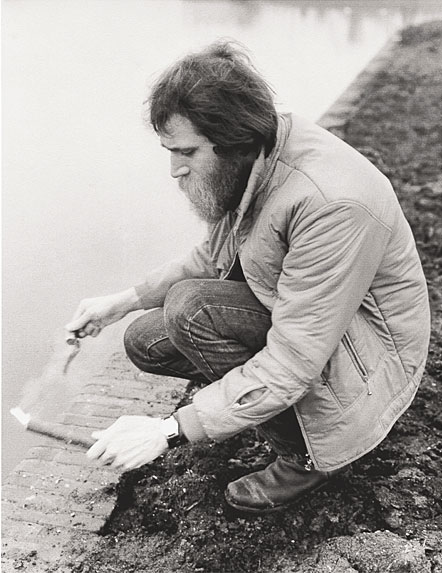|
|
| home | features | exhibitions | interviews | profiles | webprojects | gazetteer | links | archive | forum |
|
Lawrence Weiner: biography and resources Lawrence Weiner was born in New York on 10 February 1942. Self-taught as an artist, Weiner has received international recognition for his text-based conceptual pieces undertaken since the 1960s. He is currently showing on North and South Coasts of Cornwall, at Tate St Ives and Newlyn Art Gallery.
Lawrence Weiner, one of the central figures
of
When students cut down the twine because it hampered their access across the campus lawn, Weiner realized that his piece could have been even less obtrusive: viewers could have experienced the same effect Weiner desired simply by reading a verbal description of the work. Not long after this, Weiner turned to language as the primary vehicle for his work, concluding in 1968 that: (1) The artist may construct the piece. (2) The piece may be fabricated. (3) The piece may not be built. [Each being equal and consistent with the intent of the artist, the decision as to condition rests with the receiver upon the occasion of receivership.] Like other Conceptual artists who gained international recognition in the late 1960s and early 1970s, Weiner has investigated forms of display and distribution that challenge traditional assumptions about the nature of the art object. As the sole contribution to a presentation organized by Siegelaub in 1968, Weiner created a small book entitled Statements; since the work consisted of nothing but words, there was no reason to display a physical object. That same year, Weiner also contributed pages to Siegelaub’s “Xeroxbook,” a compendium of photocopies by seven Conceptually oriented artists.
As well as exhibiting with the Seth Siegelaub Gallery, New York, from 1964 to 1969, Weiner showed later with the Leo Castelli Gallery from 1971, as well as numerous venues internationally. He was involved in When Attitude becomes Form, Kunsthalle, Berne, 1969, Information, Museum of Modern Art, New York, 1970, and Documenta5, Kassel, 1972. More recently the artist has been included in the retrospective surveys, Reconsidering the Object of Art: 1965-1975, Museum of Contemporary Art, Los Angeles, 1995, and Global Conceptualism: Points of Origin, 1950s-1980s, organised by the Queens Museum of Art, New York, 1999-2000. Lawrence Weiner lives and works in New York and Amsterdam.
text extract courtesy www.guggenheimcollection.org |
|
|

 A turning point came
in 1968, when he created a work for an outdoor exhibition organized by Siegelaub at Windham College in Putney, Vermont. As his contribution to
the exhibition, Weiner proposed to define the space for his work with
rather unobtrusive means: “A series of stakes set in the ground at
regular intervals to form a rectangle—twine strung from stake to stake
to demark a grid—a rectangle removed from this rectangle.”
A turning point came
in 1968, when he created a work for an outdoor exhibition organized by Siegelaub at Windham College in Putney, Vermont. As his contribution to
the exhibition, Weiner proposed to define the space for his work with
rather unobtrusive means: “A series of stakes set in the ground at
regular intervals to form a rectangle—twine strung from stake to stake
to demark a grid—a rectangle removed from this rectangle.”  The wall installations that have been a
primary medium for Weiner since the 1970s consist solely of words in a
nondescript lettering painted on walls. The lettering need not be done
by the artist himself, as long as the sign painter complies with the
instructions dictated by the artist. Although this body of work focuses
on the potential for language to serve as an art form, the subjects of
his epigrammatic statements are often materials, or a physical action or
process, as exemplifed by such works as ONE QUART GREEN EXTERIOR
INDUSTRIAL ENAMEL THROWN ON A BRICK WALL (1968) left or EARTH TO EARTH
ASHES TO ASHES DUST TO DUST (1970). Other times the subject involves
a translation from one language to another or an encounter with a
national boundary, as in THE JOINING OF FRANCE GERMANY AND
SWITZERLAND BY ROPE (1969), or FLARE IGNITED UPON A BOUNDARY (1969)
above. In the succeeding decades, Weiner
explored the interaction of punctuation, shapes, and color to serve as
inflections of meaning for his texts. In 1997, he created Homeport
(see link below),
an interactive environment for the contemporary art web site äda'web, in
which visitors can explore a space defined by linguistic rather than
geographic features.
The wall installations that have been a
primary medium for Weiner since the 1970s consist solely of words in a
nondescript lettering painted on walls. The lettering need not be done
by the artist himself, as long as the sign painter complies with the
instructions dictated by the artist. Although this body of work focuses
on the potential for language to serve as an art form, the subjects of
his epigrammatic statements are often materials, or a physical action or
process, as exemplifed by such works as ONE QUART GREEN EXTERIOR
INDUSTRIAL ENAMEL THROWN ON A BRICK WALL (1968) left or EARTH TO EARTH
ASHES TO ASHES DUST TO DUST (1970). Other times the subject involves
a translation from one language to another or an encounter with a
national boundary, as in THE JOINING OF FRANCE GERMANY AND
SWITZERLAND BY ROPE (1969), or FLARE IGNITED UPON A BOUNDARY (1969)
above. In the succeeding decades, Weiner
explored the interaction of punctuation, shapes, and color to serve as
inflections of meaning for his texts. In 1997, he created Homeport
(see link below),
an interactive environment for the contemporary art web site äda'web, in
which visitors can explore a space defined by linguistic rather than
geographic features.